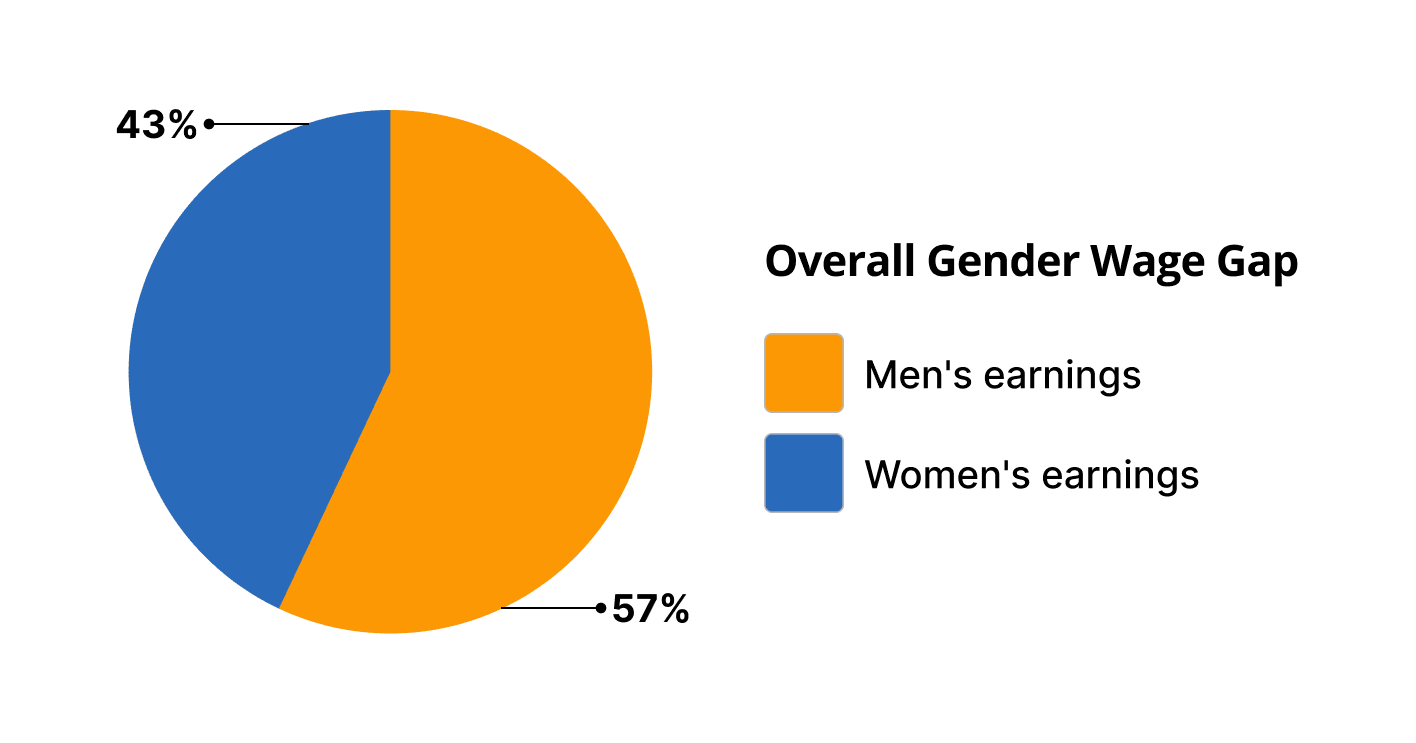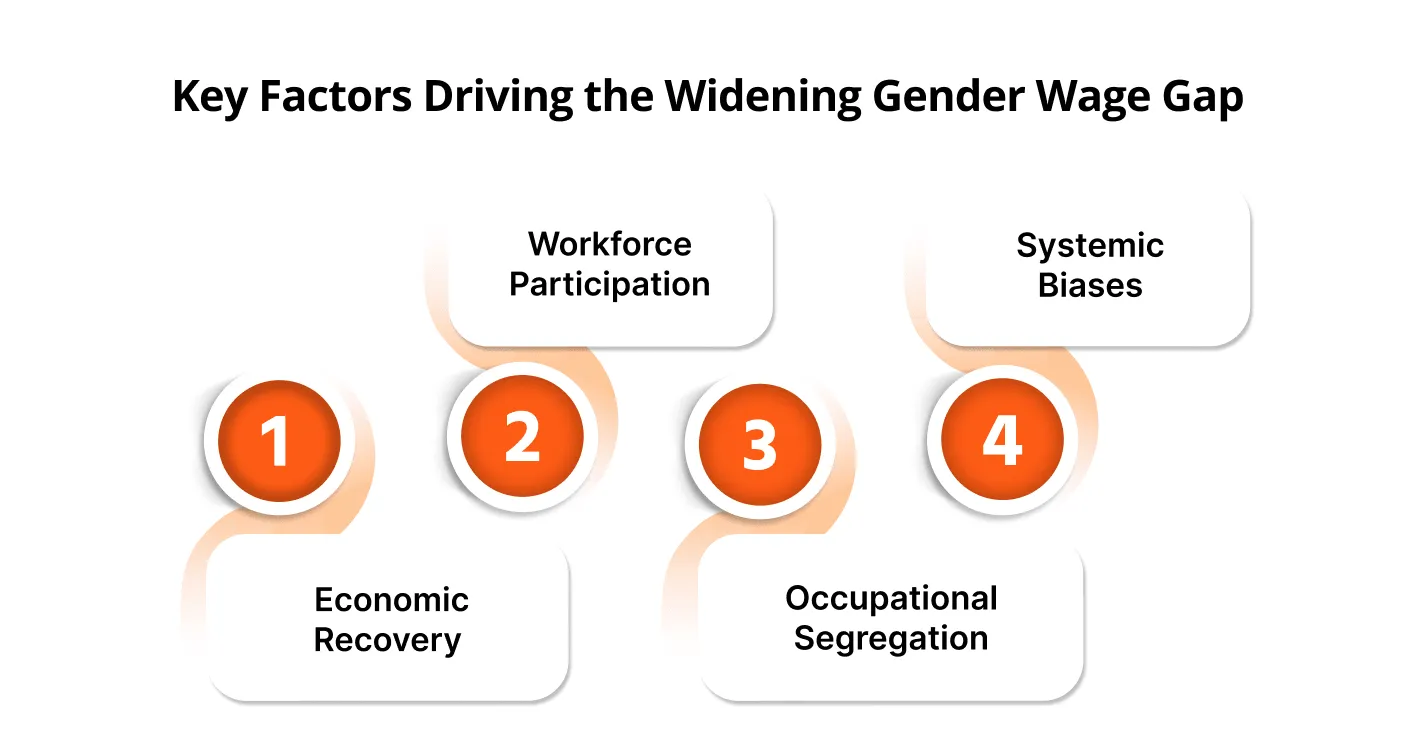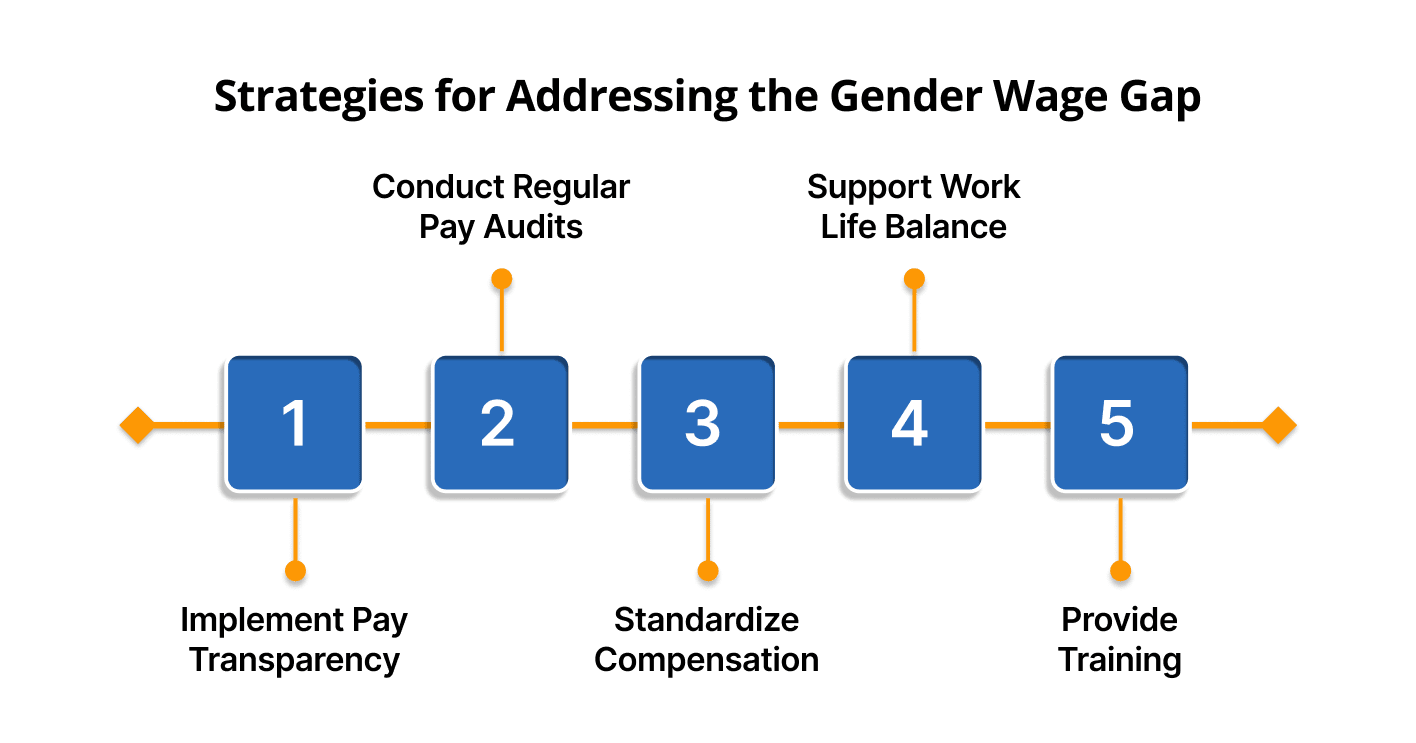
In 2025, the gender wage gap in the United States widened for the first time in two decades. Women working full-time had a median weekly earnings of $1,096, or 83.2 percent of the median weekly earnings of $1,307 for men. This represents a decrease from 83.8 percent in 2024, marking a reversal in the progress made over the past several years.
The widening gap highlights deeper challenges within workplace structures. Issues like career breaks for caregiving, unequal representation in high-paying roles, and unconscious bias still shape compensation decisions.
For businesses, this issue presents both risks and opportunities. Addressing the gender wage gap isn't just about doing what's right; it's about staying competitive, attracting top talent, and ensuring long-term success. In this article, we'll explore the factors contributing to this shift, its impact on companies, and actionable steps to ensure fair compensation for all employees.
The gender wage gap refers to the difference in average earnings between men and women in similar roles. In 2025, this gap increased for the first time in more than 20 years. On average, women now earn 78 cents for every dollar earned by men.
This disparity is present across industries and job levels, including skilled professions and leadership positions. It remains a clear sign that wage inequality continues to be a widespread issue.
As this gap continues to widen, it raises an important question about its broader impact.
The gap affects women’s financial growth and long-term stability. A yearly difference of ₹20,000 can lead to a loss of ₹6 lakh over a 30-year career. This can impact education, family support, or retirement savings.
Beyond individuals, it also reflects how companies handle pay, performance, and promotion. The widening gap affects workplace satisfaction, employee retention, and overall business outcomes.
To understand the full impact, it's important to first look at where things stand today.

After years of slow progress, pay equity in the U.S. has taken a step backward. In 2025, the gender wage gap grew wider for the first time in over two decades. The numbers show clear patterns. Women, especially women of color and those over 40, are falling further behind. And the gaps aren’t just in low-wage work; they’re also showing up in skilled industries and leadership roles. Take a look at the following numbers:
These aren’t just numbers; they point to real risks:
But what are the factors driving these gaps? Read in the section below.

Several underlying factors contribute to the widening gender wage gap in 2025, each requiring close attention from compensation teams and HR leaders. These include shifts in economic recovery, workforce participation trends, occupational segregation, and ongoing biases that influence pay decisions.
The post-pandemic economic recovery has been uneven, with men largely benefiting from a stronger rebound. While both men's and women's wages increased, men saw a more significant boost. In 2024, men's wages increased by 3%, while women's wages rose by only 1.5%. As women returned to the workforce, many re-entered lower-wage industries, contributing to the widening gap.
Women are more likely to take career breaks or work part-time due to caregiving responsibilities, affecting their long-term earnings and career growth. Research reveals that women under 40 earn $2,608 less annually than their male counterparts. For women over 40, this gap more than doubles, highlighting the impact of caregiving on career trajectory.
Women continue to dominate lower-paying industries like healthcare, education, and retail, while men hold a disproportionate share of roles in higher-paying sectors such as technology and finance. This occupational segregation contributes significantly to the wage gap, limiting opportunities for women to access well-compensated roles.
Despite advancements in policy and legal protections, biases in hiring, pay negotiations, and promotion processes still play a significant role in perpetuating the wage gap. Women often face barriers to career advancement, slower progression, and fewer opportunities for high-paying positions. These biases, whether unconscious or systemic, continue to hinder pay equity.
The widening gender wage gap in 2025 highlights the need for businesses to address these issues head-on. In the next section, we will explore the impact of the gender wage gap on organizations and why it’s critical to take action now.
The widening gender wage gap presents significant risks for businesses, ranging from financial losses to challenges in talent retention and company reputation. Addressing these consequences is crucial for organizations aiming to remain competitive and compliant in an increasingly transparent work environment.
The gender wage gap directly affects the economic health of both individuals and the broader economy. For companies, failing to address these gaps could result in missed opportunities for growth, decreased profitability, and lower employee productivity.
Pay inequity can lead to dissatisfaction, decreased morale, and higher turnover rates. Employees who feel they are not being fairly compensated for their work may become disengaged or leave for organizations that offer more equitable compensation packages. High turnover can result in increased hiring and training costs, which can undermine overall organizational performance.
As pay equity laws evolve, businesses that fail to ensure fair compensation may face legal challenges and reputational damage. Laws such as the Equal Pay Act and state-level pay transparency regulations hold employers accountable for wage disparities, and non-compliance can lead to costly lawsuits and negative publicity.
Today’s job seekers, especially millennials and Gen Z, are increasingly focused on fairness and transparency in compensation. Companies that fail to close the gender wage gap risk losing out on top talent, particularly women, who may prefer working for organizations that prioritize pay equity.
Learn key strategies that businesses can adopt to tackle the gender wage gap and build a more equitable workplace.

To close the gender wage gap, businesses must take proactive and strategic steps to ensure pay equity. Here are several key strategies that companies can implement to make meaningful progress toward gender pay equity.
One of the most effective ways to address pay disparities is to make compensation more transparent. Companies should establish clear pay bands and ensure that employees understand how their pay is determined. Transparency fosters trust and can help identify potential pay gaps, allowing businesses to take corrective actions before discrepancies become entrenched.
Regular pay audits are essential for uncovering hidden pay gaps within organizations. These audits should be comprehensive, evaluating compensation across different genders, roles, and seniority levels. Analyzing this data will enable companies to identify discrepancies and implement corrective measures.
One key driver of pay inequality is inconsistency in salary negotiations and promotions. Standardizing compensation decisions, using objective, data-driven criteria, helps remove bias and ensures that all employees are compensated fairly for their work.
Offering flexibility, such as remote work options or flexible hours, is essential for promoting pay equity. Women are more likely to take on caregiving roles, which can affect their career progression and earnings. Supporting work-life balance can help mitigate these effects and ensure that women have equal opportunities to succeed in their careers.
Investing in professional development opportunities for women can help reduce the gender wage gap over time. Offering mentorship programs, leadership training, and skills development initiatives will prepare women for higher-paying, senior roles.
While these strategies can be effective, having a partner like CompUp can further enhance their benefits.
CompUp’s suite of compensation management tools is designed to help organizations address the gender wage gap and ensure fair, transparent, and equitable pay practices.
CompUp allows organizations to streamline compensation planning by setting up compensation bands and visualizing where employees fall within those bands. This helps identify pay gaps and ensures that pay decisions are consistent and aligned with company policies.
CompUp’s pay transparency tools enable organizations to clearly communicate their pay structures to employees, reinforcing trust and accountability in the workplace. These tools support compliance with growing pay transparency regulations and provide employees with a clear understanding of their pay.
CompUp’s pay equity analysis features help organizations identify and address any discrepancies in pay. By analyzing data across various roles, demographics, and regions, CompUp ensures that companies can make informed decisions and close any gender-based wage gaps.
You can learn more about Pay Equity through our Podcast on The Pay Equity Equation
CompUp seamlessly integrates with existing HR platforms, consolidating compensation data in one unified system. This ensures that all data is accurate, up-to-date, and easily accessible, allowing organizations to make informed, fair pay decisions.
With structured pay practices, real-time data, and transparent tools, CompUp helps organizations close the gender wage gap and build a fair, inclusive workplace.
The widening gender wage gap in 2025 is a challenge that businesses can no longer ignore. Addressing this issue not only helps promote fairness and equity but also enhances employee satisfaction, boosts retention, and mitigates reputational risks. By implementing transparent pay policies, conducting regular audits, and fostering a work environment that supports all employees, businesses can take meaningful steps toward closing the gender wage gap.
Ready to close the gender wage gap in your organization? Learn how CompUp can help streamline compensation management, ensure pay equity, and foster a more transparent and inclusive workplace.
Contact us today to find out more!
1. What are the long-term effects of the gender wage gap on women’s financial security?
Women experience lower lifetime earnings, leading to reduced retirement savings and increased financial vulnerability in old age. They receive less in Social Security and pensions, having saved just 70% of retirement income compared to men.
2. How does the gender wage gap vary across different industries?
Women are overrepresented in lower-paying industries such as healthcare, education, and retail, while men dominate higher-paying sectors like finance and technology. This occupational segregation contributes significantly to the overall wage disparity.
3. What role does education play in the gender wage gap?
While higher education can reduce the wage gap, it does not eliminate it. Women with advanced degrees still earn less than their male counterparts, indicating that factors beyond education, such as occupational choices and discrimination, contribute to the wage disparity.
4. How does the gender wage gap impact organizational performance?
Pay inequity can lead to decreased employee satisfaction, lower morale, and higher turnover rates. Organizations with significant gender wage gaps may struggle to attract and retain top talent, affecting overall performance and competitiveness.
5. What are the legal implications for companies with gender wage gaps?
Companies with significant gender wage gaps may face legal challenges and reputational damage. Laws such as the Equal Pay Act and state-level pay transparency regulations hold employers accountable for wage disparities, and non-compliance can lead to costly lawsuits and negative publicity.

Co-founder & Head of Product
Anshul Mishra, Co-founder and Head of Product at CompUp, blends technology and total rewards to create smart, user-friendly solutions. He focuses on building data-driven tools that help companies design fair and effective compensation strategies, making complex processes simpler and more impactful.
Revolutionizing Pay Strategies: Don't Miss Our Latest Blogs on Compensation Benchmarking